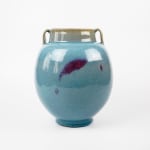Hara Kiyoshi 原 清 b. 1936
H27.9 x Dia21.8 cm
Further images
-
(View a larger image of thumbnail 1
)

-
(View a larger image of thumbnail 2
)

-
(View a larger image of thumbnail 3
)

-
(View a larger image of thumbnail 4
)

-
(View a larger image of thumbnail 5
)

-
(View a larger image of thumbnail 6
)

-
(View a larger image of thumbnail 7
)

-
(View a larger image of thumbnail 8
)

-
(View a larger image of thumbnail 9
)

-
(View a larger image of thumbnail 10
)

Hara Kiyoshi was designated in 2005 for his use of iron-based glazes (tetsu-yu) following in the footsteps of both Shimizu Uichi and Ishiguro Munemaro to become the third LNT designated for using iron-based glazes (after training with both his predecessors). The piece in the exhibition has more in common with Song Dynasty Jun ware, even down to the reduction, copper-red slash, and that’s because Hara’s work draws upon Chinese precursors just as the work of Ishiguro Munemaro and Shimizu Uichi did. This Jun-glazed ware is his second-style, as it were, and he is a master with this just as he is with the traditional browns and blacks we associate with iron containing glazes.
From the 1980s, he began to carve out his signature style by honing the use of a semi-opaque blue glaze. This blue takes on several hues: from a warm Turkish blue, to the green-blue tones of celadon. Other works take on a lighter, cool cobalt. His immersion into this color over both porcelain and stoneware has earned him the honor of being a Bearer of Intangible Cultural Heritage. He opened his own kiln in Setagaya, Tokyo in 1965. Today, Hara is an active potter and a member of the Japan Kogei Association after having exhibited extensively with an illustrious career consisting of solo exhibitions at Takashimaya, Mitsukoshi Nihonbashi, and other prestigious institutions that have done so much to promote Japanese ceramics.









